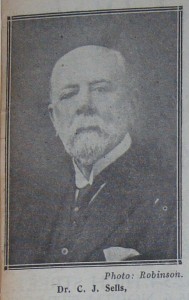Dr C J Sells MRCS, LRCP, LSA and JP was the medical officer at the workhouse (circa 1876-1922) and remembered by the Sells Ward at St. Luke’s.

The following biography of Dr Sells is written by our researcher Liz Lloyd:
“Forty Six Years of Service without Thought of Reward”
Charles John Sells, born in Guildford in 1846, was the second son of Thomas Jenner Sells and his wife Charlotte and was baptised at St Mary’s church. After being educated at the Royal Grammar School he followed his father into a medical career.
In 1867 the Surrey Advertiser reported, “C. J. Sells and Reginald Eager, the sons of our most respected medical practitioners in Guildford have passed their examination in science and the practice of medicine and have received certificates to practice.”
C. J. Sells went into practice with his father, based at their home in Guildford High Street. In 1873, aged 26, he married Emily Schofield in her home town of Grantham and as his father was now living in Leapale House, the young couple set up home at 109-110 High Street. By 1881 Charles presided over a household of 18 individuals. He and Emily had seven children under the age of 7, one daughter having died as an infant. In addition to his immediate family, his widowed mother-in-law and Emily’s sister Helen were resident and the family were served by a cook, a housemaid, 3 nurses and 2 other servants. Subsequently four more children were born to the family.
Like his father, C. J. Sells became a borough magistrate and mayor of Guildford.
As well as being surgeon to Guildford Union Infirmary, he was also appointed medical officer to the Union by the Board of Guardians. Later he became honorary consulting medical officer to the Royal Surrey County Hospital. In the early days of his tenure at the workhouse, the patients were cared for by the inmates but Dr Sells always welcomed improvements. Following the 1876 Act, provision for poor law infirmaries had to be separately, medically supervised rather than under the jurisdiction of the Master of the Workhouse, and in 1891 the minutes of the Board of Guardians report that a separate infirmary was to be established at the Union Workhouse. In 1896 the infirmary was enlarged to contain 170 beds. In 1889 C. J. Sells was appointed President of the East and West Surrey branch of the British Medical Association.
One tragic event which occurred while Dr Sells officiated at the Infirmary took place in February 1893. The Surrey Mirror reported the inquest when a verdict of , “Accidental death,” was returned for William John Short aged 3, who died in the Infirmary from burns received two weeks earlier. “He had been left in the kitchen for a few minutes and appears to have reached through the fire-guard to light a piece of paper. The result was that he caught his clothing on fire and sustained extensive injuries.”
After the death of his wife, Emily in 1897, Charles moved to White Hall, at the present day junction of the Epsom and London roads. His sons were all at school, training in medicine or independent, but his unmarried daughters, Violet and Sybil still lived with him and were described, in the census of 1901, as artists. Dr Sells went on his medical rounds in a horse and cart and on one occasion his horse slipped and fell sideways trapping Charles on the ground, but luckily he was not badly hurt. He was always interested in medical research and submitted a case study to a project on epidemiology. This was a case of acute poliomyelitis suffered by an 8 year old boy in the Workhouse Infirmary. Dr Sells reported that immediately before his death the boy’s temperature had risen to 106.4°.
In 1905 Charles married for the second time, on this occasion to Edith Willoughby Darvel, and they moved to Four Paths, Epsom Road. Dr Sells had lost 3 of his children as infants. His son Reginald Wilfred died at the age of 19 in a shooting accident and Lieutenant Archibald Jenner Sells died in Flanders in 1916. Charles Bernard Sells died at Delfontein, South Africa while serving on the medical staff of the Imperial Yeomanry hospital. Lionel Sells was also gravely ill during the Boer War, suffering from enteric fever. Thankfully he recovered and went on to become an expert in the use of X-rays. Hugh Lancelot Sells, trained in medicine in Edinburgh and was a Major in the RAMC during the first world war. After the war he became Deputy medical officer of the East Indian Railways.
On the occasion of his retirement from the position of medical officer to Guildford Poor Law Institution in 1922, a warm tribute was made to C. J Sells at a meeting of the Board of Guardians. The vice-chairman, Mr C. T. Bateman, said that, “Dr. Sells had always shown the greatest kindness to all his patients. He was always ready to do anything which might benefit the health of the people in the (Work)House.” Mr Bateman described Dr Sells as “an old-time doctor,” who had given his services without thought of reward. To mark his 46 years of service the chairman of the Board of Guardians unveiled a portrait of Dr C. J. Sells to be hung in the Board room and presented a copy to Mrs Sells.
In 1925 Charles and Edith retired to Llandrindrod Wells in Radnorshire. Although he died in Wales in September 1931, Charles John Sells was buried in the Mount cemetery in Guildford, where his first wife and infant children are also commemorated. Dr Sells was also remembered in the naming of the Sells ward at St Luke’s Hospital.
Resources:
Census and Parish records from www.Ancestry.co.uk
British Newspapers Archive www.findmypast.co.uk
Minutes of Guildford Board of Guardians:- Surrey History Centre
Guildford Biographies, Scrapbook Albums at Guildford Institute